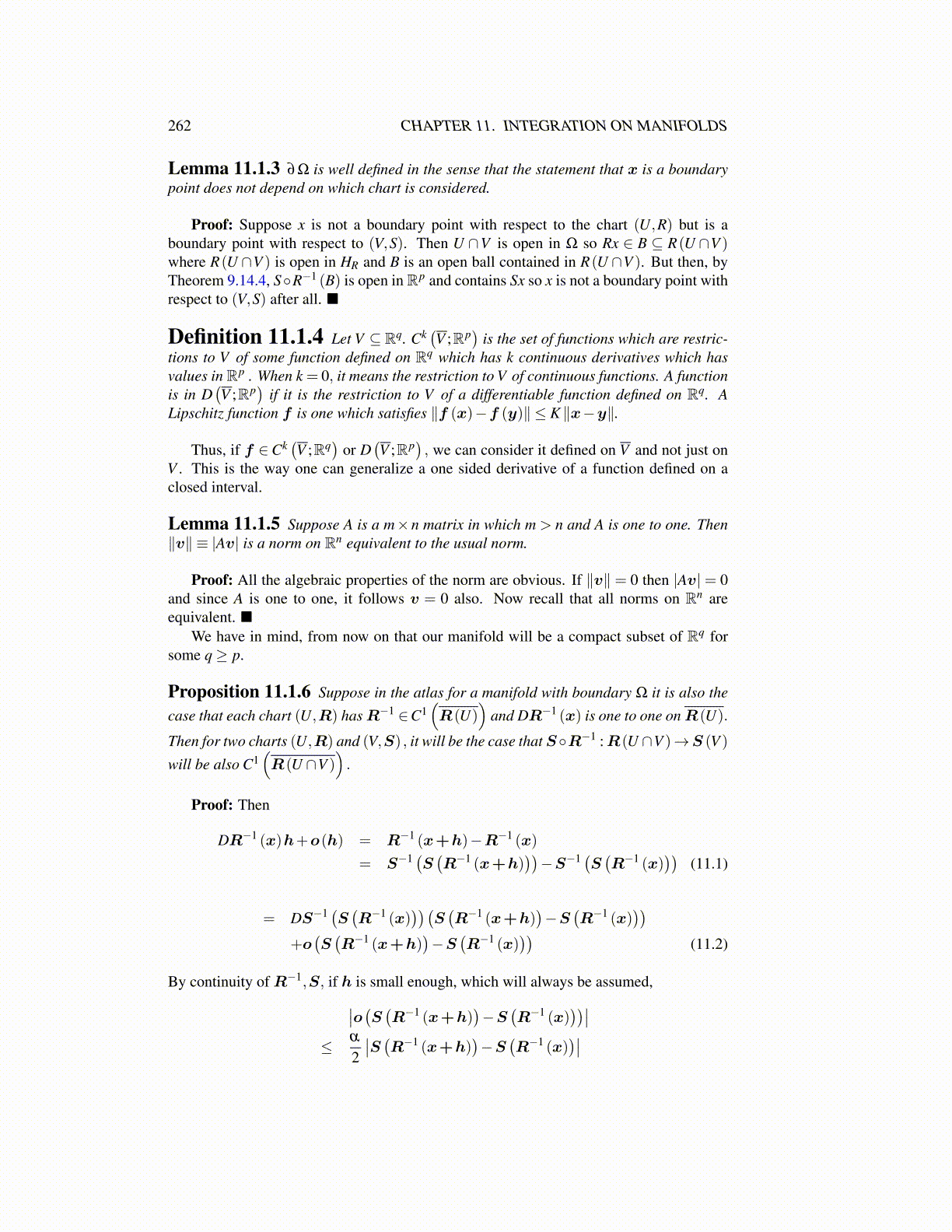
262 CHAPTER 11. INTEGRATION ON MANIFOLDS
Lemma 11.1.3 ∂Ω is well defined in the sense that the statement that x is a boundarypoint does not depend on which chart is considered.
Proof: Suppose x is not a boundary point with respect to the chart (U,R) but is aboundary point with respect to (V,S). Then U ∩V is open in Ω so Rx ∈ B ⊆ R(U ∩V )where R(U ∩V ) is open in HR and B is an open ball contained in R(U ∩V ). But then, byTheorem 9.14.4, S◦R−1 (B) is open in Rp and contains Sx so x is not a boundary point withrespect to (V,S) after all. ■
Definition 11.1.4 Let V ⊆ Rq. Ck(V ;Rp
)is the set of functions which are restric-
tions to V of some function defined on Rq which has k continuous derivatives which hasvalues in Rp . When k = 0, it means the restriction to V of continuous functions. A functionis in D
(V ;Rp
)if it is the restriction to V of a differentiable function defined on Rq. A
Lipschitz function f is one which satisfies ∥f (x)−f (y)∥ ≤ K ∥x−y∥.
Thus, if f ∈Ck(V ;Rq
)or D
(V ;Rp
), we can consider it defined on V and not just on
V . This is the way one can generalize a one sided derivative of a function defined on aclosed interval.
Lemma 11.1.5 Suppose A is a m×n matrix in which m > n and A is one to one. Then∥v∥ ≡ |Av| is a norm on Rn equivalent to the usual norm.
Proof: All the algebraic properties of the norm are obvious. If ∥v∥ = 0 then |Av| = 0and since A is one to one, it follows v = 0 also. Now recall that all norms on Rn areequivalent. ■
We have in mind, from now on that our manifold will be a compact subset of Rq forsome q≥ p.
Proposition 11.1.6 Suppose in the atlas for a manifold with boundary Ω it is also the
case that each chart (U,R) has R−1 ∈C1(R(U)
)and DR−1 (x) is one to one on R(U).
Then for two charts (U,R) and (V,S) , it will be the case that S◦R−1 :R(U ∩V )→S (V )
will be also C1(R(U ∩V )
).
Proof: Then
DR−1 (x)h+o(h) = R−1 (x+h)−R−1 (x)
= S−1 (S (R−1 (x+h)))−S−1 (S (R−1 (x)
))(11.1)
= DS−1 (S (R−1 (x)))(
S(R−1 (x+h)
)−S
(R−1 (x)
))+o(S(R−1 (x+h)
)−S
(R−1 (x)
))(11.2)
By continuity of R−1,S, if h is small enough, which will always be assumed,∣∣o(S (R−1 (x+h))−S
(R−1 (x)
))∣∣≤ α
2
∣∣S (R−1 (x+h))−S
(R−1 (x)
)∣∣